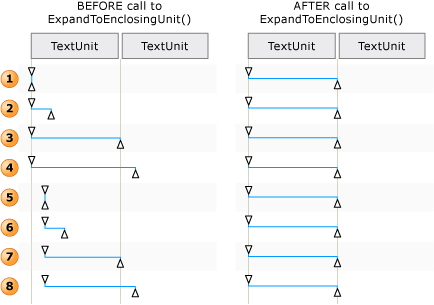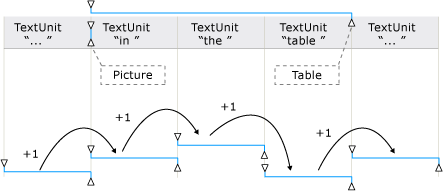TextPatternRange.Move(TextUnit, Int32) Metoda
Definicja
Ważne
Niektóre informacje odnoszą się do produktu w wersji wstępnej, który może zostać znacząco zmodyfikowany przed wydaniem. Firma Microsoft nie udziela żadnych gwarancji, jawnych lub domniemanych, w odniesieniu do informacji podanych w tym miejscu.
Przenosi zakres tekstu o określonej liczbie jednostek tekstowych.
public:
int Move(System::Windows::Automation::Text::TextUnit unit, int count);public int Move (System.Windows.Automation.Text.TextUnit unit, int count);member this.Move : System.Windows.Automation.Text.TextUnit * int -> intPublic Function Move (unit As TextUnit, count As Integer) As IntegerParametry
- unit
- TextUnit
Granica jednostki tekstowej.
- count
- Int32
Liczba jednostek tekstu do przeniesienia. Wartość dodatnia przenosi zakres tekstu do przodu, wartość ujemna przenosi zakres tekstu do tyłu, a wartość 0 nie ma wpływu.
Zwraca
Liczba jednostek rzeczywiście przeniesiona. Może to być mniejsze niż liczba żądana, jeśli jeden z punktów końcowych nowego zakresu tekstu jest większy lub mniejszy niż DocumentRange punkty końcowe.
Przykłady
/// -------------------------------------------------------------------
/// <summary>
/// Starts the target application and returns the AutomationElement
/// obtained from the targets window handle.
/// </summary>
/// <param name="exe">
/// The target application.
/// </param>
/// <param name="filename">
/// The text file to be opened in the target application
/// </param>
/// <returns>
/// An AutomationElement representing the target application.
/// </returns>
/// -------------------------------------------------------------------
private AutomationElement StartTarget(string exe, string filename)
{
// Start text editor and load with a text file.
Process p = Process.Start(exe, filename);
// targetApp --> the root AutomationElement.
AutomationElement targetApp =
AutomationElement.FromHandle(p.MainWindowHandle);
return targetApp;
}
''' -------------------------------------------------------------------
''' <summary>
''' Starts the target application and returns the AutomationElement
''' obtained from the targets window handle.
''' </summary>
''' <param name="exe">
''' The target application.
''' </param>
''' <param name="filename">
''' The text file to be opened in the target application
''' </param>
''' <returns>
''' An AutomationElement representing the target application.
''' </returns>
''' -------------------------------------------------------------------
Private Function StartTarget( _
ByVal exe As String, ByVal filename As String) As AutomationElement
' Start text editor and load with a text file.
Dim p As Process = Process.Start(exe, filename)
' targetApp --> the root AutomationElement.
Dim targetApp As AutomationElement
targetApp = AutomationElement.FromHandle(p.MainWindowHandle)
Return targetApp
End Function
/// -------------------------------------------------------------------
/// <summary>
/// Obtain the text control of interest from the target application.
/// </summary>
/// <param name="targetApp">
/// The target application.
/// </param>
/// <returns>
/// An AutomationElement that represents a text provider..
/// </returns>
/// -------------------------------------------------------------------
private AutomationElement GetTextElement(AutomationElement targetApp)
{
// The control type we're looking for; in this case 'Document'
PropertyCondition cond1 =
new PropertyCondition(
AutomationElement.ControlTypeProperty,
ControlType.Document);
// The control pattern of interest; in this case 'TextPattern'.
PropertyCondition cond2 =
new PropertyCondition(
AutomationElement.IsTextPatternAvailableProperty,
true);
AndCondition textCondition = new AndCondition(cond1, cond2);
AutomationElement targetTextElement =
targetApp.FindFirst(TreeScope.Descendants, textCondition);
// If targetText is null then a suitable text control was not found.
return targetTextElement;
}
''' -------------------------------------------------------------------
''' <summary>
''' Obtain the text control of interest from the target application.
''' </summary>
''' <param name="targetApp">
''' The target application.
''' </param>
''' <returns>
''' An AutomationElement. representing a text control.
''' </returns>
''' -------------------------------------------------------------------
Private Function GetTextElement(ByVal targetApp As AutomationElement) As AutomationElement
' The control type we're looking for; in this case 'Document'
Dim cond1 As PropertyCondition = _
New PropertyCondition( _
AutomationElement.ControlTypeProperty, _
ControlType.Document)
' The control pattern of interest; in this case 'TextPattern'.
Dim cond2 As PropertyCondition = _
New PropertyCondition( _
AutomationElement.IsTextPatternAvailableProperty, _
True)
Dim textCondition As AndCondition = New AndCondition(cond1, cond2)
Dim targetTextElement As AutomationElement = _
targetApp.FindFirst(TreeScope.Descendants, textCondition)
' If targetText is null then a suitable text control was not found.
Return targetTextElement
End Function
/// -------------------------------------------------------------------
/// <summary>
/// Moves a text range a specified number of text units. The text range
/// is the current selection.
/// </summary>
/// <param name="targetTextElement">
/// The AutomationElment that represents a text control.
/// </param>
/// <param name="textUnit">
/// The text unit value.
/// </param>
/// <param name="units">
/// The number of text units to move.
/// </param>
/// <param name="direction">
/// Direction to move the text range. Valid values are -1, 0, 1.
/// </param>
/// <returns>
/// The number of text units actually moved. This can be less than the
/// number requested if either of the new text range endpoints is
/// greater than or less than the DocumentRange endpoints.
/// </returns>
/// <remarks>
/// Moving the text range does not modify the text source in any way.
/// Only the text range starting and ending endpoints are modified.
/// </remarks>
/// -------------------------------------------------------------------
private Int32 MoveSelection(
AutomationElement targetTextElement,
TextUnit textUnit,
int units,
int direction)
{
TextPattern textPattern =
targetTextElement.GetCurrentPattern(TextPattern.Pattern)
as TextPattern;
if (textPattern == null)
{
// Target control doesn't support TextPattern.
return -1;
}
TextPatternRange[] currentSelection = textPattern.GetSelection();
if (currentSelection.Length > 1)
{
// For this example, we cannot move more than one text range.
return -1;
}
return currentSelection[0].Move(textUnit, Math.Sign(direction) * units);
}
''' -------------------------------------------------------------------
''' <summary>
''' Moves a text range a specified number of text units.
''' </summary>
''' <param name="targetTextElement">
''' The AutomationElement that represents a text control.
''' </param>
''' <param name="textUnit">
''' The text unit value.
''' </param>
''' <param name="units">
''' The number of text units to move.
''' </param>
''' <param name="direction">
''' Direction to move the text range. Valid values are -1, 0, 1.
''' </param>
''' <returns>
''' The number of text units actually moved. This can be less than the
''' number requested if either of the new text range endpoints is
''' greater than or less than the DocumentRange endpoints.
''' </returns>
''' <remarks>
''' Moving the text range does not modify the text source in any way.
''' Only the text range starting and ending endpoints are modified.
''' </remarks>
''' -------------------------------------------------------------------
Private Function MoveSelection( _
ByVal targetTextElement As AutomationElement, _
ByVal textUnit As TextUnit, _
ByVal units As Integer, _
ByVal direction As Integer) As Integer
Dim textPattern As TextPattern = _
DirectCast( _
targetTextElement.GetCurrentPattern(textPattern.Pattern), _
TextPattern)
If (textPattern Is Nothing) Then
' Target control doesn't support TextPattern.
Return -1
End If
Dim currentSelection As TextPatternRange() = _
textPattern.GetSelection()
If (currentSelection.Length > 1) Then
' For this example, we cannot move more than one text range.
Return -1
End If
Return currentSelection(0).Move(textUnit, Math.Sign(direction) * units)
End Function
Uwagi
Gdy konieczne jest przechodzenie przez zawartość zakresu tekstu, w celu Move pomyślnego wykonania metody należy wykonać serię kroków w tle.
Zakres tekstu jest znormalizowany; oznacza to, że zakres tekstu jest zwinięty do zgenerowanego zakresu w Start punkcie końcowym, co sprawia, że End punkt końcowy jest zbędny. Ten krok jest niezbędny do usunięcia niejednoznaczności w sytuacjach, w których zakres tekstu obejmuje
unitgranice, na przykład "{Lista U}RL https://www.microsoft.com/ jest osadzona w tekście", gdzie "{" i "}" są punktami końcowymi zakresu tekstu.Wynikowy zakres jest przesuwany do tyłu DocumentRange na początku żądanej
unitgranicy.Zakres jest przesuwany do przodu lub do tyłu DocumentRange przez żądaną liczbę
unitgranic.Zakres jest następnie rozszerzany z zdegenerowanego stanu zakresu przez przeniesienie End punktu końcowego przez jedną żądaną granicę
unit.

Przykłady dostosowania zakresu tekstu dla funkcji Move() i ExpandToEnclosingUnit()
Zawartość tekstowa (lub tekst wewnętrzny) kontenera tekstu i osadzony obiekt, taki jak hiperlink lub komórka tabeli, jest uwidaczniana jako pojedynczy, ciągły strumień tekstowy zarówno w widoku kontrolki, jak i w widoku zawartości drzewa automatyzacja interfejsu użytkownika; granice obiektów są ignorowane. Jeśli klient automatyzacja interfejsu użytkownika pobiera tekst na potrzeby recytowania, interpretowania lub analizowania w jakiś sposób, zakres tekstu powinien być sprawdzany pod kątem specjalnych przypadków, takich jak tabela z zawartością tekstową lub innymi osadzonymi obiektami. Można to osiągnąć przez wywołanie GetChildren metody w celu uzyskania obiektu dla każdego osadzonego obiektu, a następnie wywołanie RangeFromChild metody w celu uzyskania AutomationElement zakresu tekstu dla każdego elementu. Odbywa się to rekursywnie do momentu pobrania całej zawartości tekstowej.

Przykład strumienia tekstowego z osadzonymi obiektami i zakresami ich zakresów
Move uwzględnia zarówno tekst ukryty, jak i widoczny. Klient automatyzacja interfejsu użytkownika może sprawdzić IsHiddenAttribute widoczność tekstu.
Move odchyli wartość do następnego największego TextUnit obsługiwanego, jeśli dana TextUnit wartość nie jest obsługiwana przez kontrolkę.
Kolejność, od najmniejszej do największej jednostki, znajduje się poniżej.
Uwaga
Tekst nie jest zmieniany w żaden sposób, ponieważ zakres tekstu obejmuje tylko inną część tekstu.
